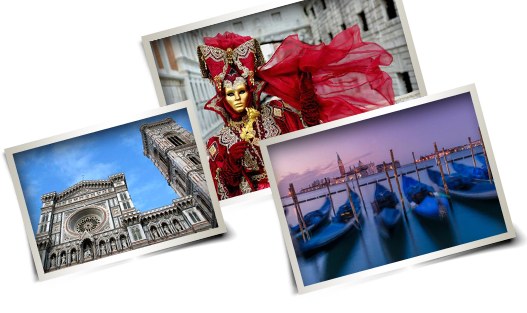''... We have been extremely fortunate to hit the jack-pot, as far as motor-bike tours go.''
... we had completed our magical mystery tour safely, made new friends along the way, and had an absolute blast! We cannot sing the praises of Clutch Moto Tours, and especially Rozle Verhovc highly enough.''
Destinations

Italy
- GENERAL INFORMATION
Location: Southern Europe, a peninsula extending into the central Mediterranean Sea, northeast of Tunisia
Border Countries: Austria 430 km, France 488 km, Holy See (Vatican City) 3.2 km, San Marino 39 km, Slovenia 199 km, Switzerland 740 km
Area: 301,340 sq km (slightly larger than Arizona)
Population: 61,482,297
Capital City: Rome (Roma) (population 2,778,000)
Religions: Christian 80% (overwhelming Roman Catholic with very small groups of Jehovah’s Witnesses and Protestants), Muslims NEGL (about 700,000 but growing), Atheists and Agnostics 20%
Government type: republic
Coastline: 0 km (landlocked)
Highest point: Mont Blanc (Monte Bianco) de Courmayeur 4,748 m (a secondary peak of Mont Blanc)
Roadways: 487,700 km
Time difference: UTC+1 (6 hours ahead of Washington, DC during Standard Time)
National currency: Euro
International dialing number: +39
Electricity: 220V, 50Hz
Visa: For visitors from most countries (EU, USA, etc) a visa is not needed. Only a valid passport is required
- CLIMATE
Predominantly Mediterranean; Alpine in far north; hot, dry in south
- TERRAIN
Mostly rugged and mountainous; some plains, coastal lowlands
- LANGUAGES
Italian (official), German (parts of Trentino-Alto Adige region are predominantly German speaking), French (small French-speaking minority in Valle d'Aosta region), Slovene (Slovene-speaking minority in the Trieste-Gorizia area)
- ETHNIC GROUPS
Italian (includes small clusters of German-, French-, and Slovene-Italians in the north and Albanian-Italians and Greek-Italians in the south)
- HISTORICAL BACKGROUND
Italy became a nation-state in 1861 when the regional states of the peninsula, along with Sardinia and Sicily, were united under King Victor EMMANUEL II. An era of parliamentary government came to a close in the early 1920s when Benito MUSSOLINI established a Fascist dictatorship. His alliance with Nazi Germany led to Italy's defeat in World War II. A democratic republic replaced the monarchy in 1946 and economic revival followed. Italy is a charter member of NATO and the European Economic Community (EEC). It has been at the forefront of European economic and political unification, joining the Economic and Monetary Union in 1999. Persistent problems include sluggish economic growth, high youth and female unemployment, organized crime, corruption, and economic disparities between southern Italy and the more prosperous north.
- ECONOMY OVERVIEW
Italy has a diversified industrial economy, which is divided into a developed industrial north, dominated by private companies, and a less-developed, highly subsidized, agricultural south, where unemployment is high. The Italian economy is driven in large part by the manufacture of high-quality consumer goods produced by small and medium-sized enterprises, many of them family-owned. Italy also has a sizable underground economy, which by some estimates accounts for as much as 17% of GDP. These activities are most common within the agriculture, construction, and service sectors. Italy is the third-largest economy in the euro-zone, but its exceptionally high public debt and structural impediments to growth have rendered it vulnerable to scrutiny by financial markets. Public debt has increased steadily since 2007, topping 126% of GDP in 2012, and investor concerns about the broader euro-zone crisis at times have caused borrowing costs on sovereign government debt to rise to euro-era records. During the second half of 2011 the government passed three austerity packages to reduce its budget deficit and help bring down borrowing costs. These measures included a hike in the value-added tax, pension reforms, and cuts to public administration. The government also faces pressure from investors and European partners to sustain its recent efforts to address Italy's long-standing structural impediments to growth, such as labor market inefficiencies and widespread tax evasion. In 2012 economic growth and labor market conditions deteriorated, with growth at -2.3% and unemployment rising to nearly 11%, with youth unemployment around 35%. The government has undertaken several reform initiatives designed to increase long-term economic growth. Italy's GDP is now 7% below its 2007 pre-crisis level.
- FLAG DESCRIPTION
Three equal vertical bands of green (hoist side), white, and red; design inspired by the French flag brought to Italy by Napoleon in 1797; colors are those of Milan (red and white) combined with the green uniform color of the Milanese civic guard (note: similar to the flag of Mexico, which is longer, uses darker shades of red and green, and has its coat of arms centered on the white band).


